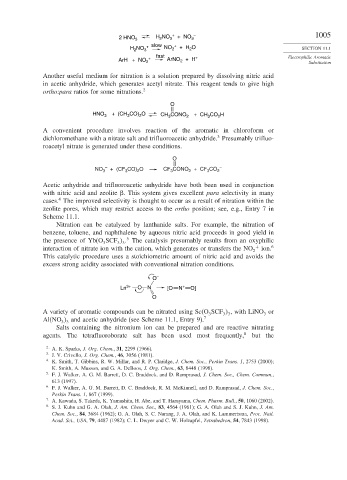Page 1029 - Advanced Organic Chemistry Part B - Reactions & Synthesis
P. 1029
+
H NO + NO – 1005
2 HNO 3 2 3 3
+ slow +
H NO 3 NO + H O SECTION 11.1
2
2
2
fast + Electrophilic Aromatic
ArH + NO 2 + ArNO + H Substitution
2
Another useful medium for nitration is a solution prepared by dissolving nitric acid
in acetic anhydride, which generates acetyl nitrate. This reagent tends to give high
ortho:para ratios for some nitrations. 2
O
+ (CH CO) O
HNO 3 3 2 CH CONO + CH CO H
3
2
3
2
A convenient procedure involves reaction of the aromatic in chloroform or
3
dichloromethane with a nitrate salt and trifluoroacetic anhydride. Presumably trifluo-
roacetyl nitrate is generated under these conditions.
O
–
NO + (CF CO) O CF CONO + CF CO 2 –
3
2
3
3
2
3
Acetic anhydride and trifluoroacetic anhydride have both been used in conjunction
with nitric acid and zeolite . This system gives excellent para selectivity in many
4
cases. The improved selectivity is thought to occur as a result of nitration within the
zeolite pores, which may restrict access to the ortho position; see, e.g., Entry 7 in
Scheme 11.1.
Nitration can be catalyzed by lanthanide salts. For example, the nitration of
benzene, toluene, and naphthalene by aqueous nitric acid proceeds in good yield in
5
the presence of Yb(O SCF . The catalysis presumably results from an oxyphilic
3 3
3
interaction of nitrate ion with the cation, which generates or transfers the NO 2 + ion. 6
This catalytic procedure uses a stoichiometric amount of nitric acid and avoids the
excess strong acidity associated with conventional nitration conditions.
O –
Ln 3+ O N [O N + O]
O
A variety of aromatic compounds can be nitrated using Sc(O SCF , with LiNO or
3 3
3
3
Al(NO and acetic anhydride (see Scheme 11.1, Entry 9). 7
3 3
Salts containing the nitronium ion can be prepared and are reactive nitrating
agents. The tetrafluoroborate salt has been used most frequently, 8 but the
2 A. K. Sparks, J. Org. Chem., 31, 2299 (1966).
3
J. V. Crivello, J. Org. Chem., 46, 3056 (1981).
4 K. Smith, T. Gibbins, R. W. Millar, and R. P. Claridge, J. Chem. Soc., Perkin Trans. 1, 2753 (2000);
K. Smith, A. Musson, and G. A. DeBoos, J. Org. Chem., 63, 8448 (1998).
5 F. J. Walker, A. G. M. Barrett, D. C. Braddock, and D. Ramprasad, J. Chem. Soc., Chem. Commun.,
613 (1997).
6
F. J. Walker, A. G. M. Barrett, D. C. Braddock, R. M. McKinnell, and D. Ramprasad, J. Chem. Soc.,
Perkin Trans. 1, 867 (1999).
7 A. Kawada, S. Takeda, K. Yamashita, H. Abe, and T. Harayama, Chem. Pharm. Bull., 50, 1060 (2002).
8
S. J. Kuhn and G. A. Olah, J. Am. Chem. Soc., 83, 4564 (1961); G. A. Olah and S. J. Kuhn, J. Am.
Chem. Soc., 84, 3684 (1962); G. A. Olah, S. C. Narang, J. A. Olah, and K. Lammertsma, Proc. Natl.
Acad. Sci., USA, 79, 4487 (1982); C. L. Dwyer and C. W. Holzapfel, Tetrahedron, 54, 7843 (1998).

